NSW Prison Reform: A Policy Analysis on Reducing Overcrowding
VerifiedAdded on 2023/06/12
|8
|1971
|238
Report
AI Summary
This report provides a policy analysis of strategies to reduce prison populations in New South Wales, Australia, focusing on the soaring assault rates in overcrowded prisons and the disproportionate imprisonment of indigenous people. It examines the history of imprisonment rates, the contemporary standing of justice reinvestment, and various stakeholders' roles in reducing Aboriginal incarceration through community empowerment, leadership, employment, recreational and healing programs. The report further delves into national reform agendas, the corrective services system in NSW, and the ethical dimensions of addressing the complex needs of women prisoners, particularly indigenous women. It concludes with evidence-based recommendations for the government to advance justice, including the establishment of rehabilitation centers, addressing individual risk factors, and recognizing the social causes of reoffending, aiming to satisfy diverse stakeholder needs and promote community safety. Desklib offers this assignment as a resource for students studying policy analysis and criminal justice.
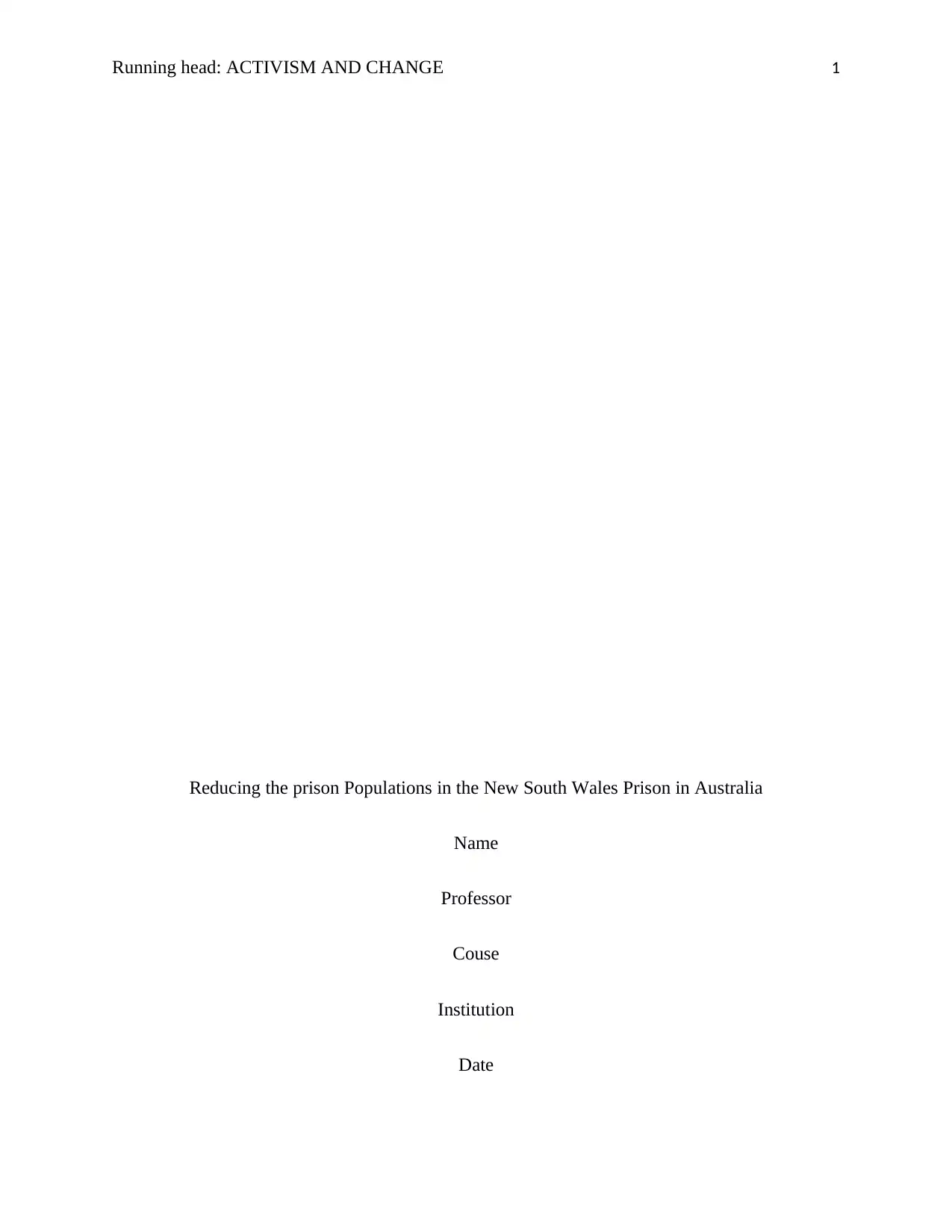
Running head: ACTIVISM AND CHANGE 1
Reducing the prison Populations in the New South Wales Prison in Australia
Name
Professor
Couse
Institution
Date
Reducing the prison Populations in the New South Wales Prison in Australia
Name
Professor
Couse
Institution
Date
Paraphrase This Document
Need a fresh take? Get an instant paraphrase of this document with our AI Paraphraser
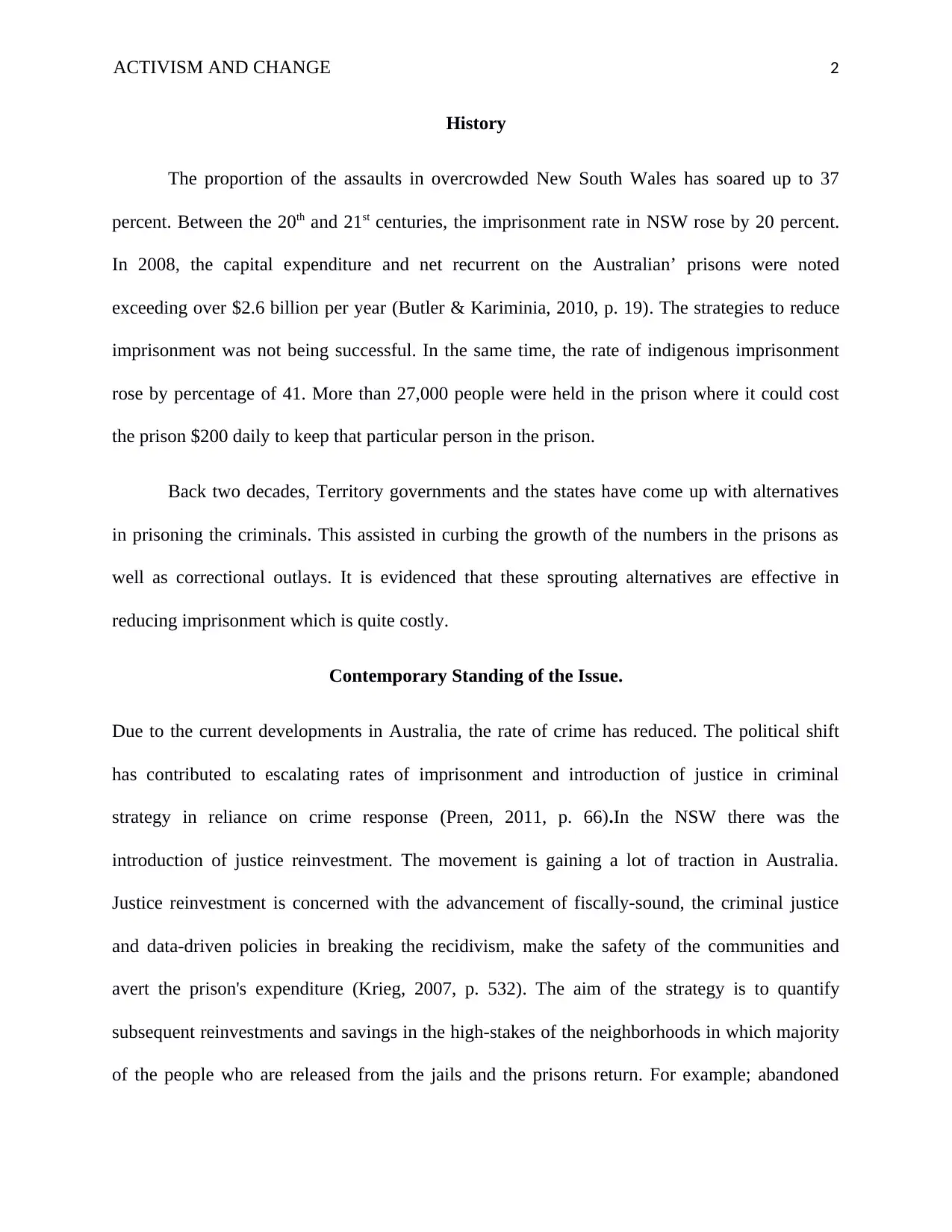
ACTIVISM AND CHANGE 2
History
The proportion of the assaults in overcrowded New South Wales has soared up to 37
percent. Between the 20th and 21st centuries, the imprisonment rate in NSW rose by 20 percent.
In 2008, the capital expenditure and net recurrent on the Australian’ prisons were noted
exceeding over $2.6 billion per year (Butler & Kariminia, 2010, p. 19). The strategies to reduce
imprisonment was not being successful. In the same time, the rate of indigenous imprisonment
rose by percentage of 41. More than 27,000 people were held in the prison where it could cost
the prison $200 daily to keep that particular person in the prison.
Back two decades, Territory governments and the states have come up with alternatives
in prisoning the criminals. This assisted in curbing the growth of the numbers in the prisons as
well as correctional outlays. It is evidenced that these sprouting alternatives are effective in
reducing imprisonment which is quite costly.
Contemporary Standing of the Issue.
Due to the current developments in Australia, the rate of crime has reduced. The political shift
has contributed to escalating rates of imprisonment and introduction of justice in criminal
strategy in reliance on crime response (Preen, 2011, p. 66).In the NSW there was the
introduction of justice reinvestment. The movement is gaining a lot of traction in Australia.
Justice reinvestment is concerned with the advancement of fiscally-sound, the criminal justice
and data-driven policies in breaking the recidivism, make the safety of the communities and
avert the prison's expenditure (Krieg, 2007, p. 532). The aim of the strategy is to quantify
subsequent reinvestments and savings in the high-stakes of the neighborhoods in which majority
of the people who are released from the jails and the prisons return. For example; abandoned
History
The proportion of the assaults in overcrowded New South Wales has soared up to 37
percent. Between the 20th and 21st centuries, the imprisonment rate in NSW rose by 20 percent.
In 2008, the capital expenditure and net recurrent on the Australian’ prisons were noted
exceeding over $2.6 billion per year (Butler & Kariminia, 2010, p. 19). The strategies to reduce
imprisonment was not being successful. In the same time, the rate of indigenous imprisonment
rose by percentage of 41. More than 27,000 people were held in the prison where it could cost
the prison $200 daily to keep that particular person in the prison.
Back two decades, Territory governments and the states have come up with alternatives
in prisoning the criminals. This assisted in curbing the growth of the numbers in the prisons as
well as correctional outlays. It is evidenced that these sprouting alternatives are effective in
reducing imprisonment which is quite costly.
Contemporary Standing of the Issue.
Due to the current developments in Australia, the rate of crime has reduced. The political shift
has contributed to escalating rates of imprisonment and introduction of justice in criminal
strategy in reliance on crime response (Preen, 2011, p. 66).In the NSW there was the
introduction of justice reinvestment. The movement is gaining a lot of traction in Australia.
Justice reinvestment is concerned with the advancement of fiscally-sound, the criminal justice
and data-driven policies in breaking the recidivism, make the safety of the communities and
avert the prison's expenditure (Krieg, 2007, p. 532). The aim of the strategy is to quantify
subsequent reinvestments and savings in the high-stakes of the neighborhoods in which majority
of the people who are released from the jails and the prisons return. For example; abandoned
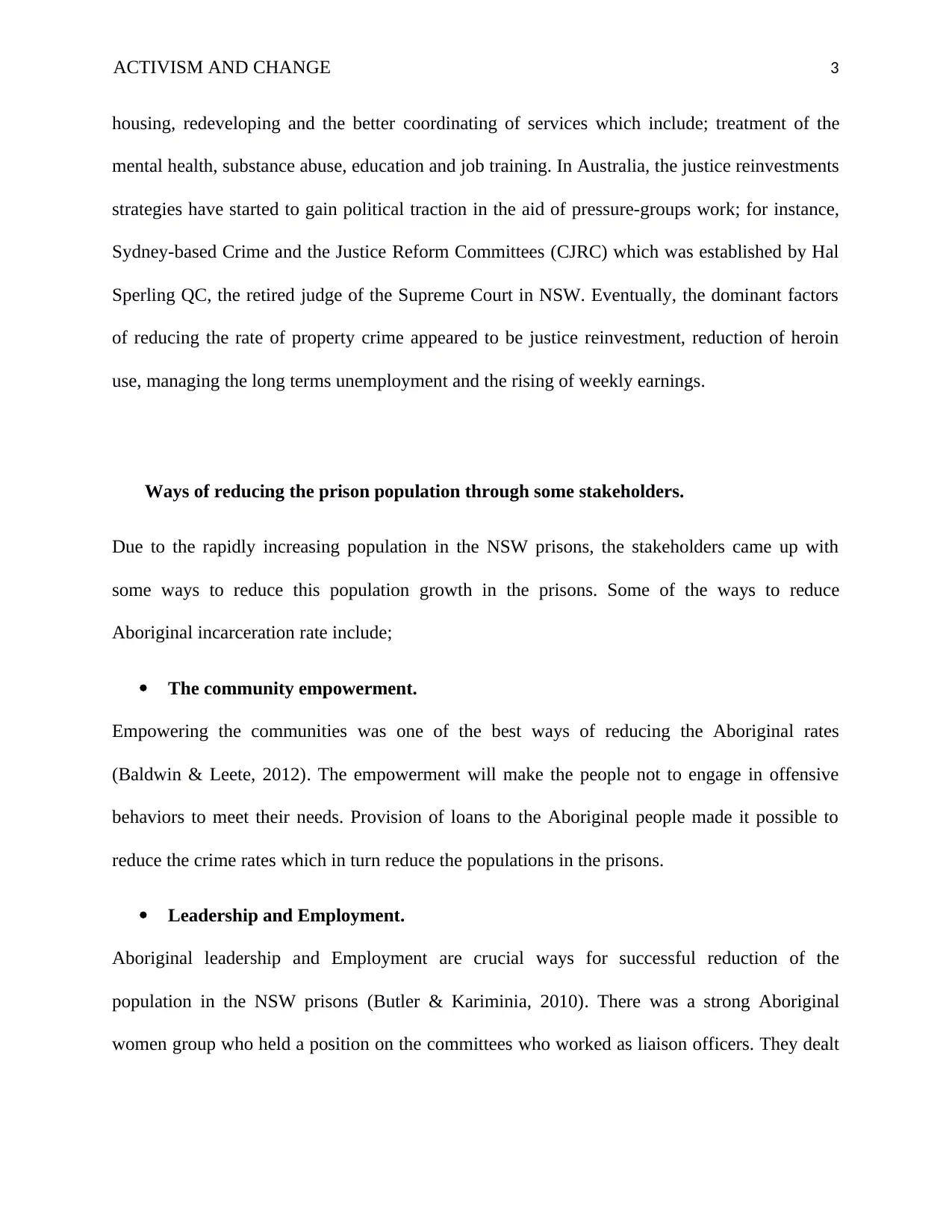
ACTIVISM AND CHANGE 3
housing, redeveloping and the better coordinating of services which include; treatment of the
mental health, substance abuse, education and job training. In Australia, the justice reinvestments
strategies have started to gain political traction in the aid of pressure-groups work; for instance,
Sydney-based Crime and the Justice Reform Committees (CJRC) which was established by Hal
Sperling QC, the retired judge of the Supreme Court in NSW. Eventually, the dominant factors
of reducing the rate of property crime appeared to be justice reinvestment, reduction of heroin
use, managing the long terms unemployment and the rising of weekly earnings.
Ways of reducing the prison population through some stakeholders.
Due to the rapidly increasing population in the NSW prisons, the stakeholders came up with
some ways to reduce this population growth in the prisons. Some of the ways to reduce
Aboriginal incarceration rate include;
The community empowerment.
Empowering the communities was one of the best ways of reducing the Aboriginal rates
(Baldwin & Leete, 2012). The empowerment will make the people not to engage in offensive
behaviors to meet their needs. Provision of loans to the Aboriginal people made it possible to
reduce the crime rates which in turn reduce the populations in the prisons.
Leadership and Employment.
Aboriginal leadership and Employment are crucial ways for successful reduction of the
population in the NSW prisons (Butler & Kariminia, 2010). There was a strong Aboriginal
women group who held a position on the committees who worked as liaison officers. They dealt
housing, redeveloping and the better coordinating of services which include; treatment of the
mental health, substance abuse, education and job training. In Australia, the justice reinvestments
strategies have started to gain political traction in the aid of pressure-groups work; for instance,
Sydney-based Crime and the Justice Reform Committees (CJRC) which was established by Hal
Sperling QC, the retired judge of the Supreme Court in NSW. Eventually, the dominant factors
of reducing the rate of property crime appeared to be justice reinvestment, reduction of heroin
use, managing the long terms unemployment and the rising of weekly earnings.
Ways of reducing the prison population through some stakeholders.
Due to the rapidly increasing population in the NSW prisons, the stakeholders came up with
some ways to reduce this population growth in the prisons. Some of the ways to reduce
Aboriginal incarceration rate include;
The community empowerment.
Empowering the communities was one of the best ways of reducing the Aboriginal rates
(Baldwin & Leete, 2012). The empowerment will make the people not to engage in offensive
behaviors to meet their needs. Provision of loans to the Aboriginal people made it possible to
reduce the crime rates which in turn reduce the populations in the prisons.
Leadership and Employment.
Aboriginal leadership and Employment are crucial ways for successful reduction of the
population in the NSW prisons (Butler & Kariminia, 2010). There was a strong Aboriginal
women group who held a position on the committees who worked as liaison officers. They dealt
⊘ This is a preview!⊘
Do you want full access?
Subscribe today to unlock all pages.

Trusted by 1+ million students worldwide
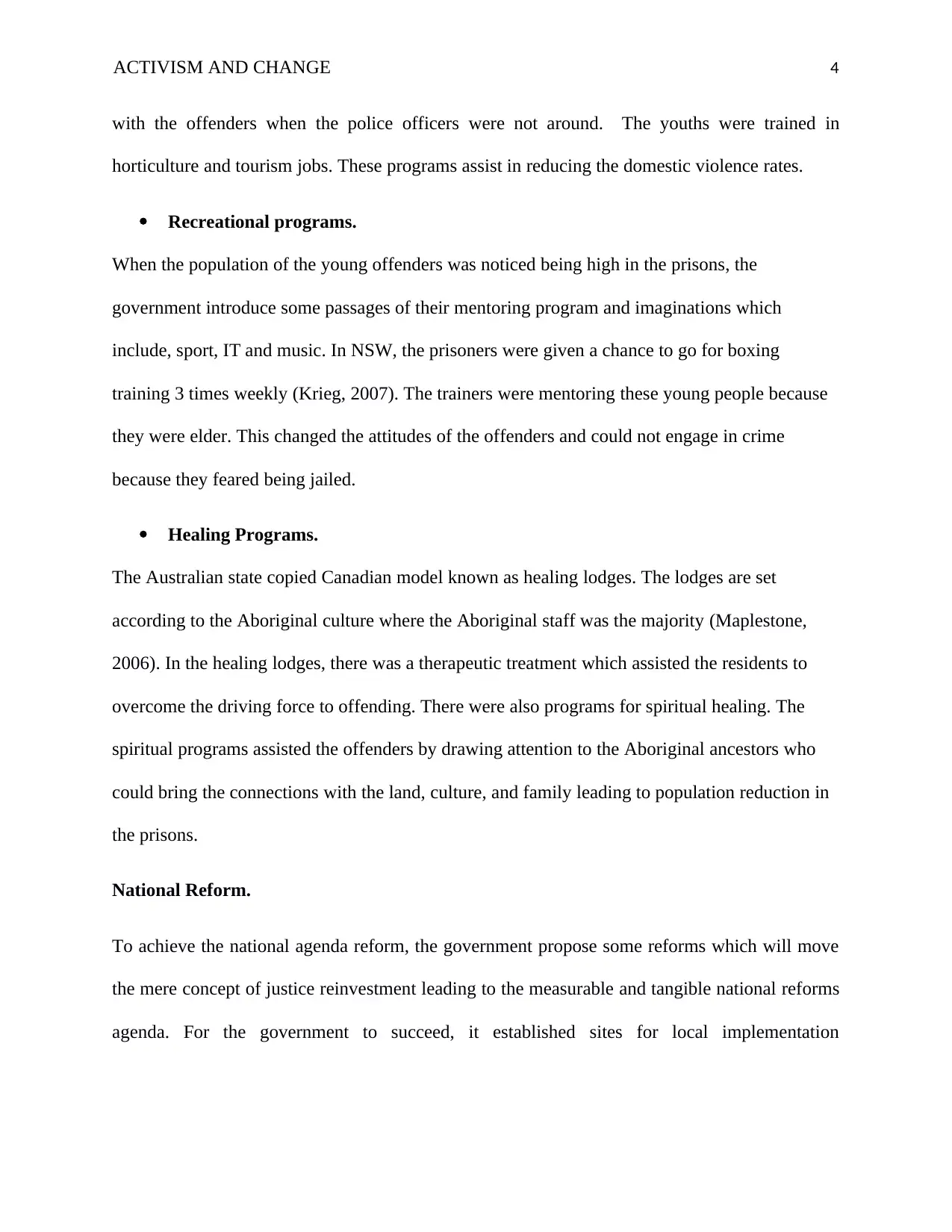
ACTIVISM AND CHANGE 4
with the offenders when the police officers were not around. The youths were trained in
horticulture and tourism jobs. These programs assist in reducing the domestic violence rates.
Recreational programs.
When the population of the young offenders was noticed being high in the prisons, the
government introduce some passages of their mentoring program and imaginations which
include, sport, IT and music. In NSW, the prisoners were given a chance to go for boxing
training 3 times weekly (Krieg, 2007). The trainers were mentoring these young people because
they were elder. This changed the attitudes of the offenders and could not engage in crime
because they feared being jailed.
Healing Programs.
The Australian state copied Canadian model known as healing lodges. The lodges are set
according to the Aboriginal culture where the Aboriginal staff was the majority (Maplestone,
2006). In the healing lodges, there was a therapeutic treatment which assisted the residents to
overcome the driving force to offending. There were also programs for spiritual healing. The
spiritual programs assisted the offenders by drawing attention to the Aboriginal ancestors who
could bring the connections with the land, culture, and family leading to population reduction in
the prisons.
National Reform.
To achieve the national agenda reform, the government propose some reforms which will move
the mere concept of justice reinvestment leading to the measurable and tangible national reforms
agenda. For the government to succeed, it established sites for local implementation
with the offenders when the police officers were not around. The youths were trained in
horticulture and tourism jobs. These programs assist in reducing the domestic violence rates.
Recreational programs.
When the population of the young offenders was noticed being high in the prisons, the
government introduce some passages of their mentoring program and imaginations which
include, sport, IT and music. In NSW, the prisoners were given a chance to go for boxing
training 3 times weekly (Krieg, 2007). The trainers were mentoring these young people because
they were elder. This changed the attitudes of the offenders and could not engage in crime
because they feared being jailed.
Healing Programs.
The Australian state copied Canadian model known as healing lodges. The lodges are set
according to the Aboriginal culture where the Aboriginal staff was the majority (Maplestone,
2006). In the healing lodges, there was a therapeutic treatment which assisted the residents to
overcome the driving force to offending. There were also programs for spiritual healing. The
spiritual programs assisted the offenders by drawing attention to the Aboriginal ancestors who
could bring the connections with the land, culture, and family leading to population reduction in
the prisons.
National Reform.
To achieve the national agenda reform, the government propose some reforms which will move
the mere concept of justice reinvestment leading to the measurable and tangible national reforms
agenda. For the government to succeed, it established sites for local implementation
Paraphrase This Document
Need a fresh take? Get an instant paraphrase of this document with our AI Paraphraser
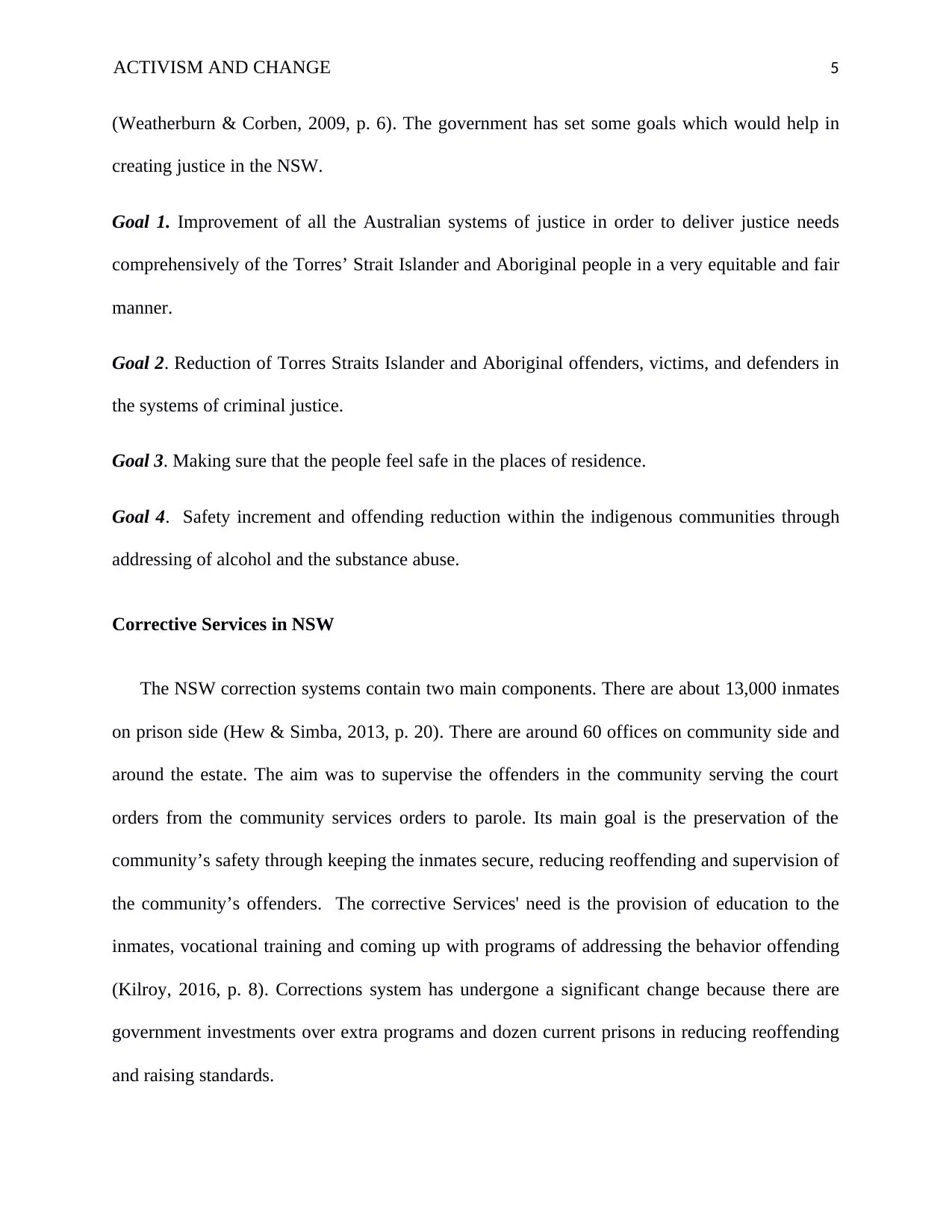
ACTIVISM AND CHANGE 5
(Weatherburn & Corben, 2009, p. 6). The government has set some goals which would help in
creating justice in the NSW.
Goal 1. Improvement of all the Australian systems of justice in order to deliver justice needs
comprehensively of the Torres’ Strait Islander and Aboriginal people in a very equitable and fair
manner.
Goal 2. Reduction of Torres Straits Islander and Aboriginal offenders, victims, and defenders in
the systems of criminal justice.
Goal 3. Making sure that the people feel safe in the places of residence.
Goal 4. Safety increment and offending reduction within the indigenous communities through
addressing of alcohol and the substance abuse.
Corrective Services in NSW
The NSW correction systems contain two main components. There are about 13,000 inmates
on prison side (Hew & Simba, 2013, p. 20). There are around 60 offices on community side and
around the estate. The aim was to supervise the offenders in the community serving the court
orders from the community services orders to parole. Its main goal is the preservation of the
community’s safety through keeping the inmates secure, reducing reoffending and supervision of
the community’s offenders. The corrective Services' need is the provision of education to the
inmates, vocational training and coming up with programs of addressing the behavior offending
(Kilroy, 2016, p. 8). Corrections system has undergone a significant change because there are
government investments over extra programs and dozen current prisons in reducing reoffending
and raising standards.
(Weatherburn & Corben, 2009, p. 6). The government has set some goals which would help in
creating justice in the NSW.
Goal 1. Improvement of all the Australian systems of justice in order to deliver justice needs
comprehensively of the Torres’ Strait Islander and Aboriginal people in a very equitable and fair
manner.
Goal 2. Reduction of Torres Straits Islander and Aboriginal offenders, victims, and defenders in
the systems of criminal justice.
Goal 3. Making sure that the people feel safe in the places of residence.
Goal 4. Safety increment and offending reduction within the indigenous communities through
addressing of alcohol and the substance abuse.
Corrective Services in NSW
The NSW correction systems contain two main components. There are about 13,000 inmates
on prison side (Hew & Simba, 2013, p. 20). There are around 60 offices on community side and
around the estate. The aim was to supervise the offenders in the community serving the court
orders from the community services orders to parole. Its main goal is the preservation of the
community’s safety through keeping the inmates secure, reducing reoffending and supervision of
the community’s offenders. The corrective Services' need is the provision of education to the
inmates, vocational training and coming up with programs of addressing the behavior offending
(Kilroy, 2016, p. 8). Corrections system has undergone a significant change because there are
government investments over extra programs and dozen current prisons in reducing reoffending
and raising standards.
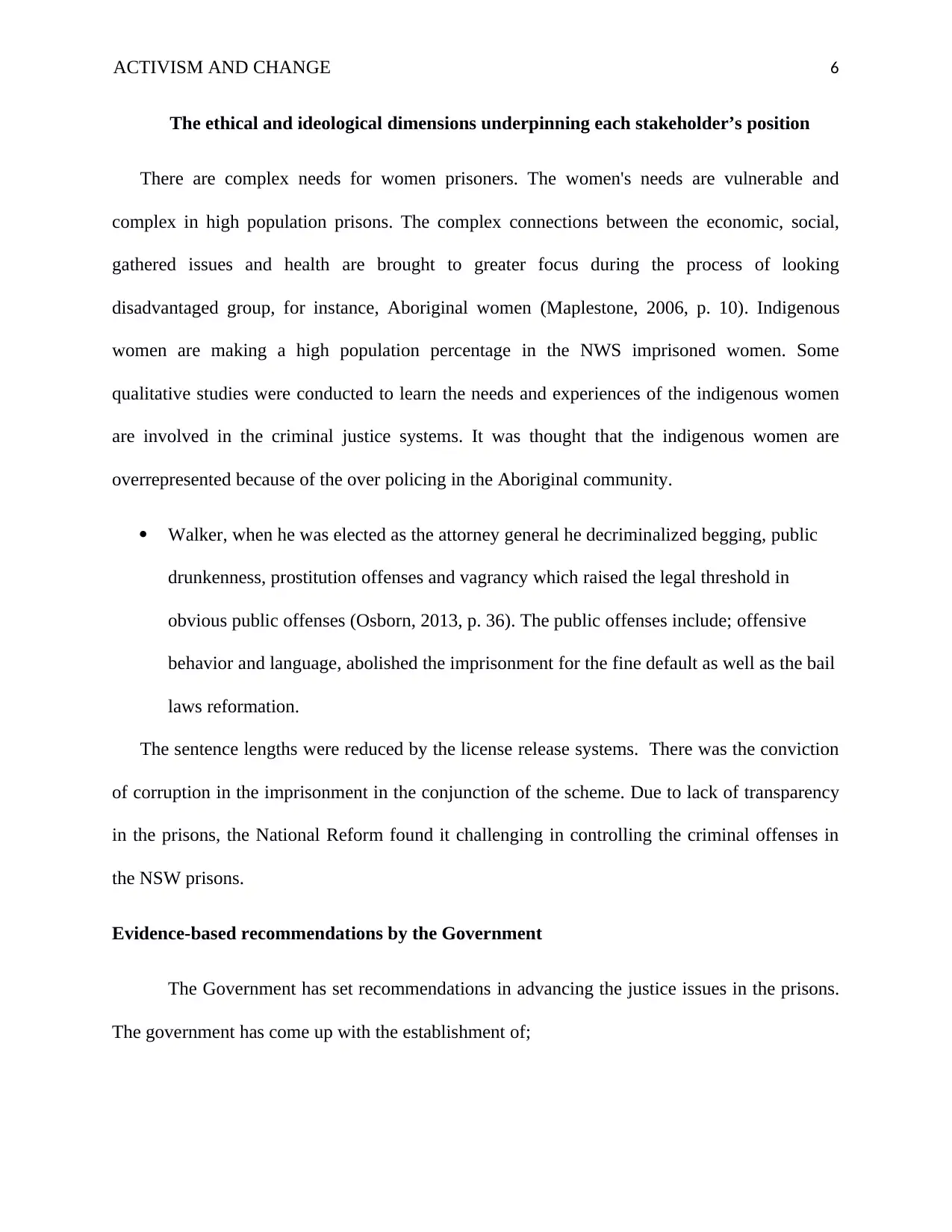
ACTIVISM AND CHANGE 6
The ethical and ideological dimensions underpinning each stakeholder’s position
There are complex needs for women prisoners. The women's needs are vulnerable and
complex in high population prisons. The complex connections between the economic, social,
gathered issues and health are brought to greater focus during the process of looking
disadvantaged group, for instance, Aboriginal women (Maplestone, 2006, p. 10). Indigenous
women are making a high population percentage in the NWS imprisoned women. Some
qualitative studies were conducted to learn the needs and experiences of the indigenous women
are involved in the criminal justice systems. It was thought that the indigenous women are
overrepresented because of the over policing in the Aboriginal community.
Walker, when he was elected as the attorney general he decriminalized begging, public
drunkenness, prostitution offenses and vagrancy which raised the legal threshold in
obvious public offenses (Osborn, 2013, p. 36). The public offenses include; offensive
behavior and language, abolished the imprisonment for the fine default as well as the bail
laws reformation.
The sentence lengths were reduced by the license release systems. There was the conviction
of corruption in the imprisonment in the conjunction of the scheme. Due to lack of transparency
in the prisons, the National Reform found it challenging in controlling the criminal offenses in
the NSW prisons.
Evidence-based recommendations by the Government
The Government has set recommendations in advancing the justice issues in the prisons.
The government has come up with the establishment of;
The ethical and ideological dimensions underpinning each stakeholder’s position
There are complex needs for women prisoners. The women's needs are vulnerable and
complex in high population prisons. The complex connections between the economic, social,
gathered issues and health are brought to greater focus during the process of looking
disadvantaged group, for instance, Aboriginal women (Maplestone, 2006, p. 10). Indigenous
women are making a high population percentage in the NWS imprisoned women. Some
qualitative studies were conducted to learn the needs and experiences of the indigenous women
are involved in the criminal justice systems. It was thought that the indigenous women are
overrepresented because of the over policing in the Aboriginal community.
Walker, when he was elected as the attorney general he decriminalized begging, public
drunkenness, prostitution offenses and vagrancy which raised the legal threshold in
obvious public offenses (Osborn, 2013, p. 36). The public offenses include; offensive
behavior and language, abolished the imprisonment for the fine default as well as the bail
laws reformation.
The sentence lengths were reduced by the license release systems. There was the conviction
of corruption in the imprisonment in the conjunction of the scheme. Due to lack of transparency
in the prisons, the National Reform found it challenging in controlling the criminal offenses in
the NSW prisons.
Evidence-based recommendations by the Government
The Government has set recommendations in advancing the justice issues in the prisons.
The government has come up with the establishment of;
⊘ This is a preview!⊘
Do you want full access?
Subscribe today to unlock all pages.

Trusted by 1+ million students worldwide
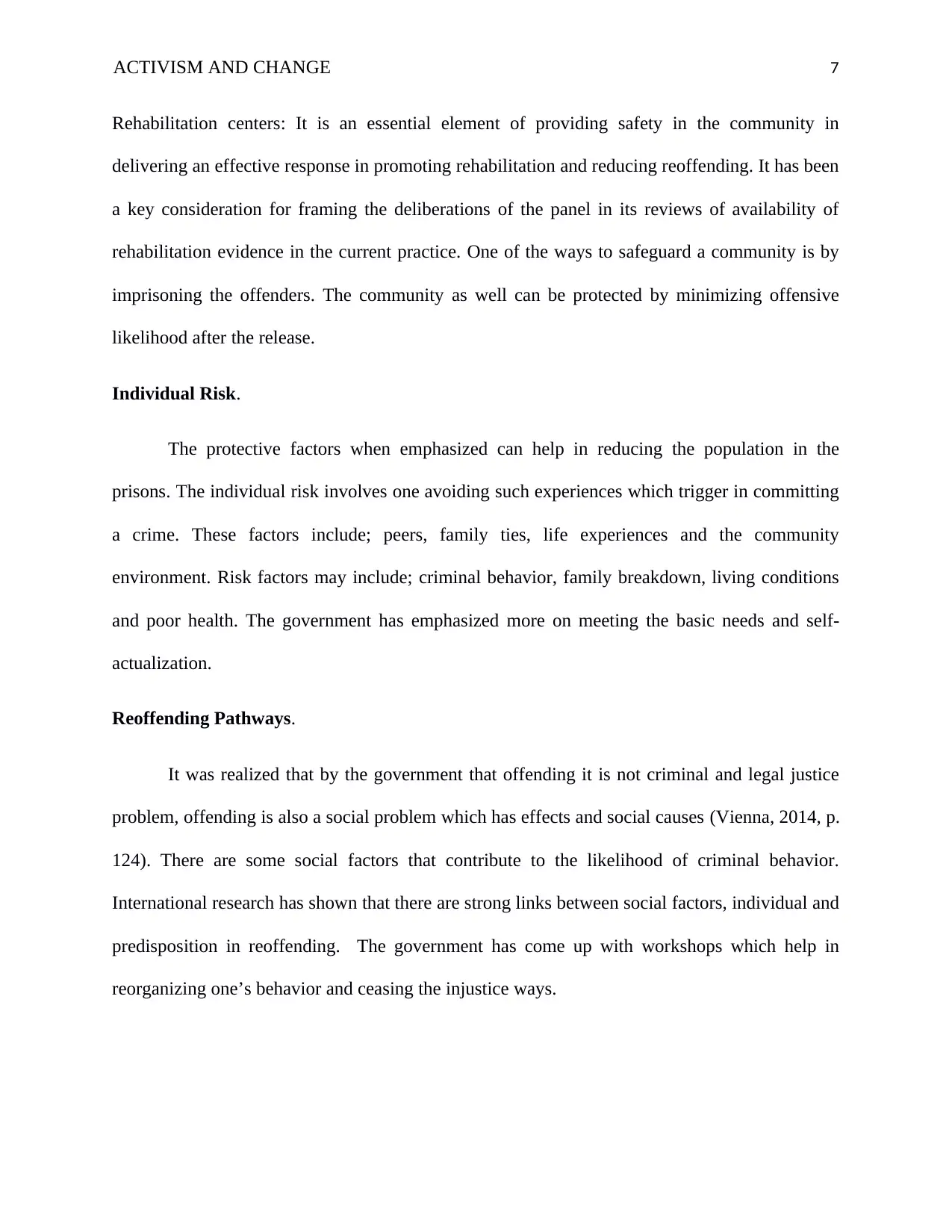
ACTIVISM AND CHANGE 7
Rehabilitation centers: It is an essential element of providing safety in the community in
delivering an effective response in promoting rehabilitation and reducing reoffending. It has been
a key consideration for framing the deliberations of the panel in its reviews of availability of
rehabilitation evidence in the current practice. One of the ways to safeguard a community is by
imprisoning the offenders. The community as well can be protected by minimizing offensive
likelihood after the release.
Individual Risk.
The protective factors when emphasized can help in reducing the population in the
prisons. The individual risk involves one avoiding such experiences which trigger in committing
a crime. These factors include; peers, family ties, life experiences and the community
environment. Risk factors may include; criminal behavior, family breakdown, living conditions
and poor health. The government has emphasized more on meeting the basic needs and self-
actualization.
Reoffending Pathways.
It was realized that by the government that offending it is not criminal and legal justice
problem, offending is also a social problem which has effects and social causes (Vienna, 2014, p.
124). There are some social factors that contribute to the likelihood of criminal behavior.
International research has shown that there are strong links between social factors, individual and
predisposition in reoffending. The government has come up with workshops which help in
reorganizing one’s behavior and ceasing the injustice ways.
Rehabilitation centers: It is an essential element of providing safety in the community in
delivering an effective response in promoting rehabilitation and reducing reoffending. It has been
a key consideration for framing the deliberations of the panel in its reviews of availability of
rehabilitation evidence in the current practice. One of the ways to safeguard a community is by
imprisoning the offenders. The community as well can be protected by minimizing offensive
likelihood after the release.
Individual Risk.
The protective factors when emphasized can help in reducing the population in the
prisons. The individual risk involves one avoiding such experiences which trigger in committing
a crime. These factors include; peers, family ties, life experiences and the community
environment. Risk factors may include; criminal behavior, family breakdown, living conditions
and poor health. The government has emphasized more on meeting the basic needs and self-
actualization.
Reoffending Pathways.
It was realized that by the government that offending it is not criminal and legal justice
problem, offending is also a social problem which has effects and social causes (Vienna, 2014, p.
124). There are some social factors that contribute to the likelihood of criminal behavior.
International research has shown that there are strong links between social factors, individual and
predisposition in reoffending. The government has come up with workshops which help in
reorganizing one’s behavior and ceasing the injustice ways.
Paraphrase This Document
Need a fresh take? Get an instant paraphrase of this document with our AI Paraphraser
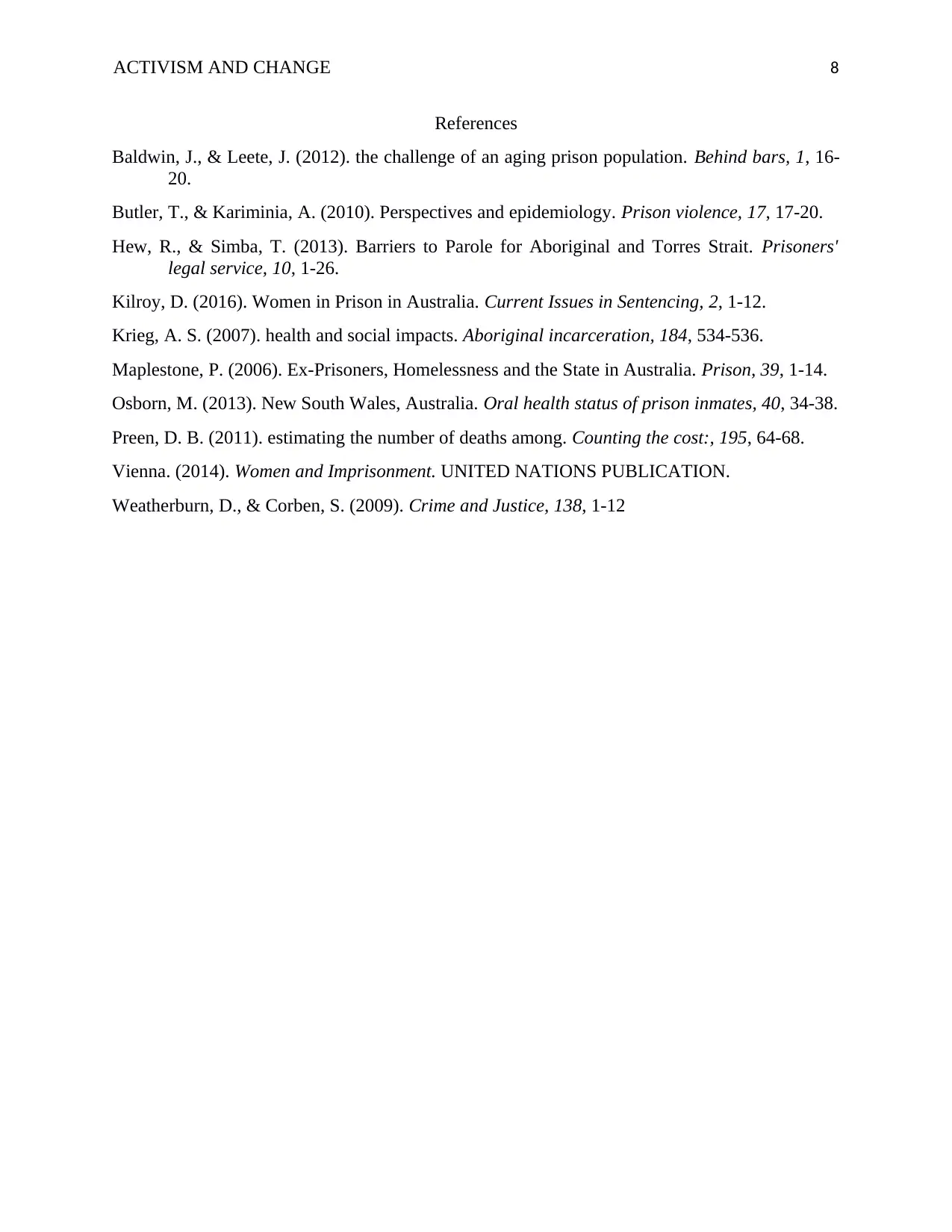
ACTIVISM AND CHANGE 8
References
Baldwin, J., & Leete, J. (2012). the challenge of an aging prison population. Behind bars, 1, 16-
20.
Butler, T., & Kariminia, A. (2010). Perspectives and epidemiology. Prison violence, 17, 17-20.
Hew, R., & Simba, T. (2013). Barriers to Parole for Aboriginal and Torres Strait. Prisoners'
legal service, 10, 1-26.
Kilroy, D. (2016). Women in Prison in Australia. Current Issues in Sentencing, 2, 1-12.
Krieg, A. S. (2007). health and social impacts. Aboriginal incarceration, 184, 534-536.
Maplestone, P. (2006). Ex-Prisoners, Homelessness and the State in Australia. Prison, 39, 1-14.
Osborn, M. (2013). New South Wales, Australia. Oral health status of prison inmates, 40, 34-38.
Preen, D. B. (2011). estimating the number of deaths among. Counting the cost:, 195, 64-68.
Vienna. (2014). Women and Imprisonment. UNITED NATIONS PUBLICATION.
Weatherburn, D., & Corben, S. (2009). Crime and Justice, 138, 1-12
References
Baldwin, J., & Leete, J. (2012). the challenge of an aging prison population. Behind bars, 1, 16-
20.
Butler, T., & Kariminia, A. (2010). Perspectives and epidemiology. Prison violence, 17, 17-20.
Hew, R., & Simba, T. (2013). Barriers to Parole for Aboriginal and Torres Strait. Prisoners'
legal service, 10, 1-26.
Kilroy, D. (2016). Women in Prison in Australia. Current Issues in Sentencing, 2, 1-12.
Krieg, A. S. (2007). health and social impacts. Aboriginal incarceration, 184, 534-536.
Maplestone, P. (2006). Ex-Prisoners, Homelessness and the State in Australia. Prison, 39, 1-14.
Osborn, M. (2013). New South Wales, Australia. Oral health status of prison inmates, 40, 34-38.
Preen, D. B. (2011). estimating the number of deaths among. Counting the cost:, 195, 64-68.
Vienna. (2014). Women and Imprisonment. UNITED NATIONS PUBLICATION.
Weatherburn, D., & Corben, S. (2009). Crime and Justice, 138, 1-12
1 out of 8
Your All-in-One AI-Powered Toolkit for Academic Success.
+13062052269
info@desklib.com
Available 24*7 on WhatsApp / Email
![[object Object]](/_next/static/media/star-bottom.7253800d.svg)
Unlock your academic potential
Copyright © 2020–2025 A2Z Services. All Rights Reserved. Developed and managed by ZUCOL.

